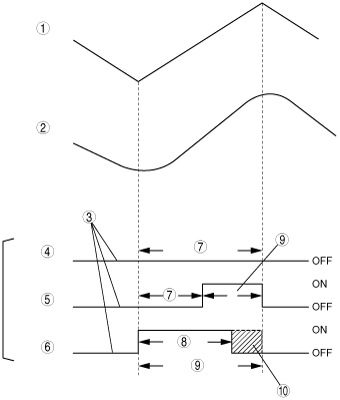HIGH PRESSURE FUEL PUMP CONSTRUCTION/OPERATION [L3 Turbo]
id0114b4101700
Construction
• Located on left side (drive plate side) of the cylinder head.
• Consists of a spill valve control solenoid valve, spill valve, camshaft, piston, and spring.
Operation
• Fuel is suctioned and pumped due to the up and down movement of the piston caused by the rotation of the 3 head cam installed to the rear end of the camshaft (intake side).
• Fuel pressure is adjusted by the spill valve control solenoid valve, and has a relief valve for fail-safe operation. If the fuel pressure in the fuel delivery pipe reaches 13 MPa {132 kgf/cm2, 1885 psi}, the relief valve opens and fuel is returned upstream by the high pressure fuel pump.
• When the spill valve control solenoid valve is off, the spill valve is open and fuel pushed out by the piston is returned to upstream, and fuel pressure lowers. When the spill valve control solenoid valve is on, the spill valve is close and fuel pushed out by the piston is discharged to the fuel delivery pipe, and fuel pressure rises.
• The following chart shows the energization to the spill valve control solenoid valve and the open/close of the spill valve.
|
1
|
Cam lift quantity
|
|
2
|
Fuel pressure (in case of all discharge to the fuel coil)
|
|
3
|
Spill valve control solenoid valve operation time
|
|
4
|
All relief
|
|
5
|
50% discharge
|
|
6
|
All discharge
|
|
7
|
Spill valve open
|
|
8
|
Solenoid on
|
|
9
|
Spill valve close
|
|
10
|
Even if the spill valve control solenoid valve is off, the spill valve closes
|
-
― ALL RELIEF: Fuel is returned upstream while the spill valve control solenoid valve remains off.
― 50% DISCHARGE: The spill valve control solenoid valve is on at the latter 50% of the discharge control area, and fuel is discharged while the spill valve is closed in the same area.
― ALL DISCHARGE: The spill valve control solenoid valve turns on at the beginning of the discharge control range and turns off at the end of the range: however, the spill valve closes naturally during the discharging process due to the fuel pressure increase. Due to this, damage to the spill valve control solenoid valve from the excessive temperature increase is prevented.
